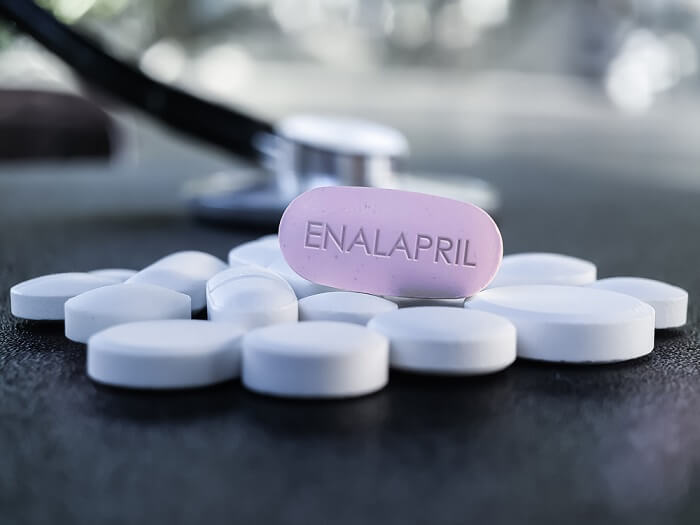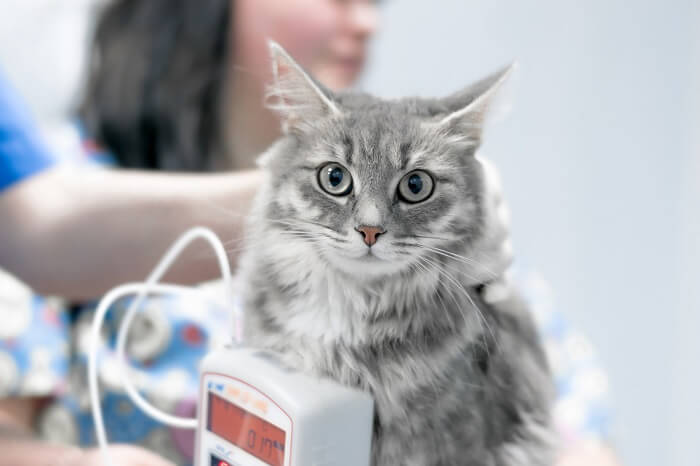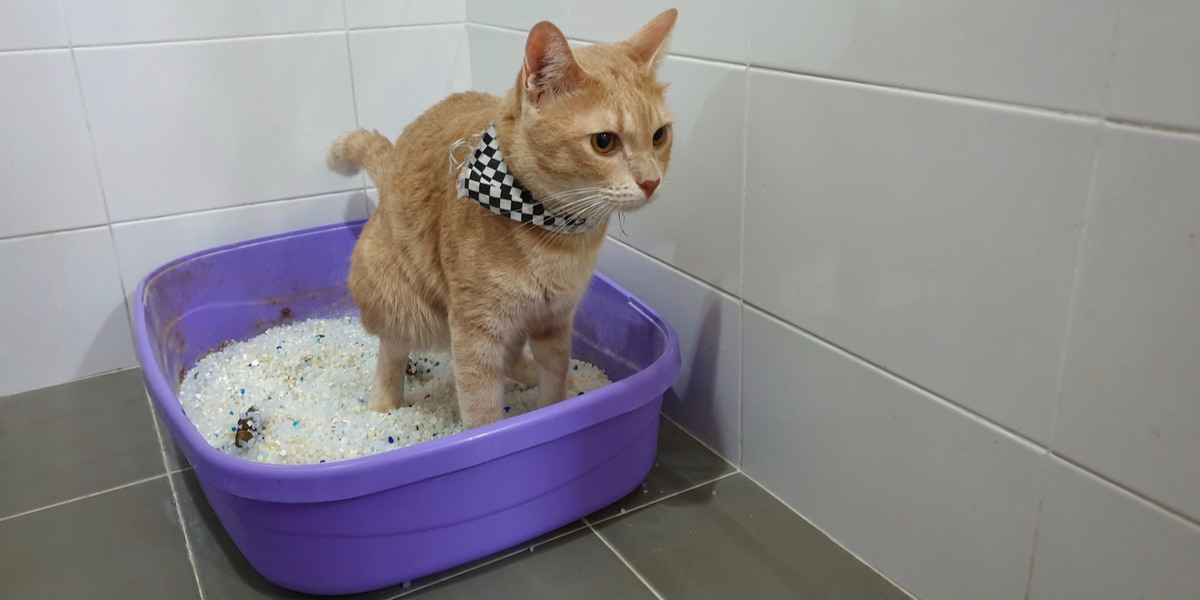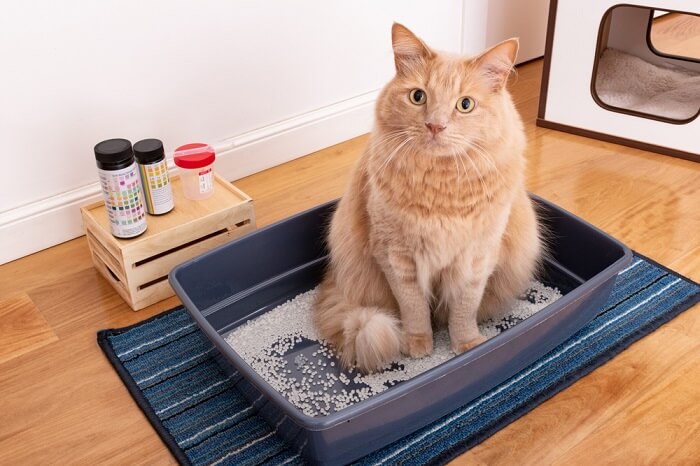
Enalapril is a blood pressure medication used in veterinary medicine to treat kitties with heart failure, hypertension (high blood pressure), chronic kidney disease, and conditions of protein loss through the urine. It may also be known by the brand names Enacard or Vasotec.
Enalapril for Cats Overview

In this article, you’ll learn how enalapril works, situations where it is most commonly used, side effects, and some frequently asked questions.
About Enalapril for Cats

Enalapril is classified as an angiotensin-converting enzyme (ACE) inhibitor.
Angiotensin-converting enzyme inhibitors work by blocking the conversion of the protein hormone angiotensin-I to angiotensin-II. Angiotensin-II causes blood vessels to constrict and also stimulates the production of a hormone called aldosterone.
Blood vessel constriction and high levels of aldosterone in the body can increase blood pressure. By blocking the conversion to angiotensin-II, ACE inhibitors help to lower blood pressure.
In pets with congestive heart failure (CHF), dilating the blood vessels also helps to reduce strain on the heart because it doesn’t have to work as hard to push blood through the body.
In pets with protein loss through the urine, enalapril helps by relieving resistance in the filtration system of the kidney called the glomerulus, preserving kidney function.
What Is Enalapril Used for in Cats?

Enalapril is used to treat hypertension, high levels of protein in the urine and to aid in the treatment of congestive heart failure.
Enalapril has three main applications for use in cats:
- The first is as a second-line blood pressure medication to treat high blood pressure, or hypertension. Many veterinarians will start first with a different medication called amlodipine. However, in cases where amlodipine improves a cat’s hypertension, but the blood pressure still is not normal, a second medication needs to be added. A common choice is either enalapril or its close cousin, benazepril. Telmisartan, a newer medication gaining popularity for use in cats in recent years, may also be considered.
- Enalapril can also be used to address high levels of protein in the urine. This indicates that body protein, which the kidneys typically conserve, is being lost in higher amounts. In many (but not all) cases, high levels of proteinuria can indicate kidney dysfunction. Enalapril can help to lower pressure in the tiny capillary blood vessels of the glomerulus, which is the main filtration structure of the kidney. This improves kidney blood flow and can help reduce protein loss.
- Enalapril’s third application is to aid in the treatment of congestive heart failure. It is not always the first-line preference in all cases, but may help by reducing blood pressure and workload on the heart.
Side Effects of Enalapril for Cats

Enalapril is typically well-tolerated when used at proper dosages, making serious side effects uncommon. Sometimes, vomiting or diarrhea may occur. While the medication can be given with or without food, giving with food may help reduce the occurrence of digestive upset.
With any blood pressure medication, there is always the possibility of blood pressure getting too low, especially if an extra dose or too high a dose is accidentally given. Low blood pressure is called hypotension. This is why dosage adjustments should only be made based on recheck blood pressure measurements.
While enalapril can be used to assist cats in congestive heart failure, it does need to be used carefully, especially if there are any blood electrolyte abnormalities, or certain complications of heart disease. These types of contraindications for its use can usually be determined when a cat is under the care of a board certified veterinary cardiologist.
Enalapril for Cats With Kidney Disease

Enalapril must be used carefully in cats with existing kidney disease. Part of the role of enalapril to help reduce protein loss in the urine is to slow down the filtration rate in the kidneys. However, slowing down the filtration rate can also increase levels of certain waste products in the bloodstream, like blood urea nitrogen (BUN) and creatinine. An increase of these waste products as found on bloodwork is called azotemia. Azotemia can be associated with adverse effects, like loss of appetite and vomiting.
Cats with mild to moderate kidney disease may be unaffected and the benefits for reducing blood pressure and protein loss may outweigh potential risks. But enalapril is typically used very carefully in pets with moderate levels of azotemia and is considered inappropriate to use in cats with advanced kidney disease or acute kidney injury (such as that caused by a kidney infection or a toxin).
Enalapril’s safety for pregnant or nursing animals is questionable. It is considered contraindicated in some countries for pregnant or lactating animals.
Because enalapril can interact with several other medications, drug interactions are another reason to consult with your vet to see if this medication can be used in conjunction with other drugs your kitty might be taking.
Enalapril for Cats Dosage

Enalapril needs to be used carefully, especially with certain medical conditions so it is best to have your veterinarian determine what dosage to start with.
The dosage for enalapril for cats, as well as the frequency of dosing, can differ depending on the intended use.
This is also a medication that needs to be used carefully, especially with certain medical conditions. For this reason, it is best to have your veterinarian determine if enalapril is okay to start and what dosage to start with.
Enalapril dosages should also only be adjusted based on recheck testing, including blood pressure measurements and checking urine protein levels. It’s not advisable to adjust enalapril dosages on your own, without recheck testing with your vet.
Conclusion

Enalapril can be a very useful medication for addressing some conditions of high blood pressure, urine protein loss, and heart disease in cats. However, it should be used very carefully as it is not an appropriate medication for these conditions in all situations. If you think your cat might benefit from enalapril, make sure to have a conversation with your vet.
Frequently Asked Questions
What is Enalapril Used for in Cats?
Enalapril is an angiotensin-converting enzyme (ACE) inhibitor used as a blood pressure medication for hypertension. It also has applications to help reduce protein loss through the kidneys and urine and can be of use as an adjunctive medication for cats with heart disease and congestive heart failure.
What are the Side Effects of Enalapril in Cats?
Enalapril is generally very well tolerated by most cats. Signs of digestive upset may be seen and if so, it is best to give this medication with food.
It must be used carefully in cases of advanced kidney disease and heart failure and so should always be prescribed under a veterinarian’s supervision.
Will Enalapril Hurt My Cat?
Most cats that benefit from use of an ACE-inhibitor generally tolerate enalapril quite well as long as it is being dosed properly. Digestive upset may be seen in some cases.
While enalapril can help facilitate improvements in heart function, kidney function, and blood pressure, enalapril must also be used carefully with certain kidney and heart conditions, depending on their severity.
Any medication not used as prescribed can be detrimental to a cat’s health, which is why it is very important to only use a medication like enalapril as prescribed by your kitty’s veterinarian.
Is Enalapril Bad for Kidneys?
In most cases, no. Enalapril has protective effects on the kidney by relieving pressure in the capillaries that comprise the filtration systems of the kidneys, aiding in reducing protein loss.
However, enalapril must also be used carefully in cats with existing kidney disease. In relieving capillary resistance and pressure, enalapril also slows down the filtration rate in the kidneys. Slowing down the filtration rate may increase levels of certain waste products in the bloodstream, like blood urea nitrogen (BUN) and creatinine.
Cats with mild to moderate kidney disease may be unaffected and the benefits for reducing blood pressure and protein loss may outweigh potential risks. But enalapril is typically used very carefully in pets with moderate levels of kidney dysfunction and is considered inappropriate to use in cats with advanced kidney disease or acute kidney injury (such as that caused by a kidney infection or a toxin).
It is common to check lab work values after starting a medication like enalapril, to make sure there have been no changes to kidney function.
When starting any medication, it is important to discuss the risks and benefits with your veterinarian, as well as to follow any dosing instructions your vet advises.







